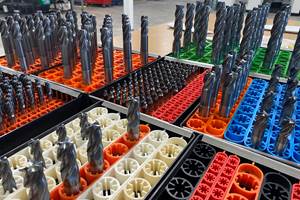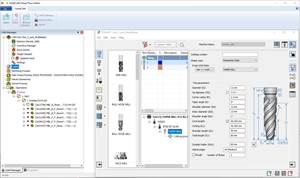CAD/CAM Converges With CNC
Both CAD/CAM systems and now CNCs have rushed to the same operating platform--the personal computer.
Even though CAD/CAM and CNC are next-door neighbors in the process chain of preparing and then executing part programs, the two technologies have historically been worlds apart. CAD/CAM is supposed to be all about working directly with geometry. CNC is for controlling machines. And for the two to talk at all, geometrical intentions have to be translated into the arcane language of G and M codes to be acted out in the physical environment of the machine.
This paradigm is so fundamental to numerical control technology as we've known it that we hardly can think of it being any other way. However, as both CAD/CAM systems and now CNCs have rushed to the same operating platform--the personal computer--all the old rules are set to be broken. Add the burgeoning multimedia capabilities of the PC, and the potential of next-generation CAD/CAM/CNC technology looks most interesting indeed. A company on the forefront of this technology is CamSoft (Lake Elsinore, California) who has combined multimedia CAD/CAM and PC-based motion controllers into a single product. Now the personal computer has the capability to control the servo motors directly from the graphics shown on the CAD/CAM screen.
And that's going to require CNC shops to think very differently about the technology they've known so well all these years. Says CamSoft president Gary Corey, "It is difficult to grasp the concept that there does not have to be G code any more and that CAD/CAM graphics and motion control can be interactive in real-time. In fact, there is no code at all to deal with. No typing mistakes. No postprocessor problems. The graphics on the screen that the user draws or imports from his or her CAD system automatically becomes motion."
The CAD/CAM portion of the system runs in a Microsoft Windows operating environment. Among its more conventional features are 3D multi-surface cutting, multiple viewports, CAD links, a large database and a built-in interactive technical support button. It also provides high-resolution, graphic verification of part programs, showing the tool and workpiece as a full 3D solid model.
The multimedia aspects of the system allow text, graphics or sound to be associated with a part program. This way all sorts of job notes, setup instructions, part drawings, tool libraries or other information can be electronically delivered to the CNC on the shop floor where it can be accessed by the setup person or operator.
The PC-based motion control software and hardware toolkit allow users to create and customize their own controller for any two- to five-axis machine tool. This capability, in combination with the CAD/CAM software, allows the machine tool to work directly from workpiece geometry. The basic concept is to convert the graphic drawing--whether it is created in the system or imported via DXF, IGES, Gerber or HPGL protocols--directly to axis motion. No G-code programs need to be written or reviewed (though G-code programs can be read if necessary). And no postprocessors. Moreover, there is now effectively no limitation on program size, which should prove to be particularly important with large 3D contouring routines.
The minimum hardware requirement for the controller, says CamSoft, is a 90 MHz, Pentium computer with 40 MB of hard disk space, a 1.44 MB floppy drive, two RS-232 ports, a Super VGA color card and a joystick or trackball. No PLCs are needed.
CamSoft has a booklet that will answer all of the common questions that would normally arise when examining this new technology for the first time.
Related Content
Grinding Simulation Enables Growth in Custom Tooling
Simulation software both streamlines Gorilla Mill's grinding machine setups and speeds up the company's tooling design and verification processes.
Read MoreBuilding A Powerful Bridge from the CAM Programmer to the Shop Floor Operator
SolidCAM for Operators provides a powerful bridge from CAM programming to the shop floor to best streamline the machine shop process with its CAM part simulation. It provides a clear picture to the operator for setup and prove-out, enables minor G-Code changes and avoids crashes, broken tools and scrapped parts.
Read MoreWhen to Use Custom Macros With a CAM System
Custom macros can offer benefits even when using a CAM system to prepare programs – but must be implemented with the right considerations.
Read MoreIMTS Takeaways From the Modern Machine Shop Editorial Team
The first in-person IMTS in four years left the MMS editorial staff with a lot to digest. Here are a few of our takeaways from the show floor.
Read MoreRead Next
3 Mistakes That Cause CNC Programs to Fail
Despite enhancements to manufacturing technology, there are still issues today that can cause programs to fail. These failures can cause lost time, scrapped parts, damaged machines and even injured operators.
Read MoreThe Cut Scene: The Finer Details of Large-Format Machining
Small details and features can have an outsized impact on large parts, such as Barbco’s collapsible utility drill head.
Read More

























